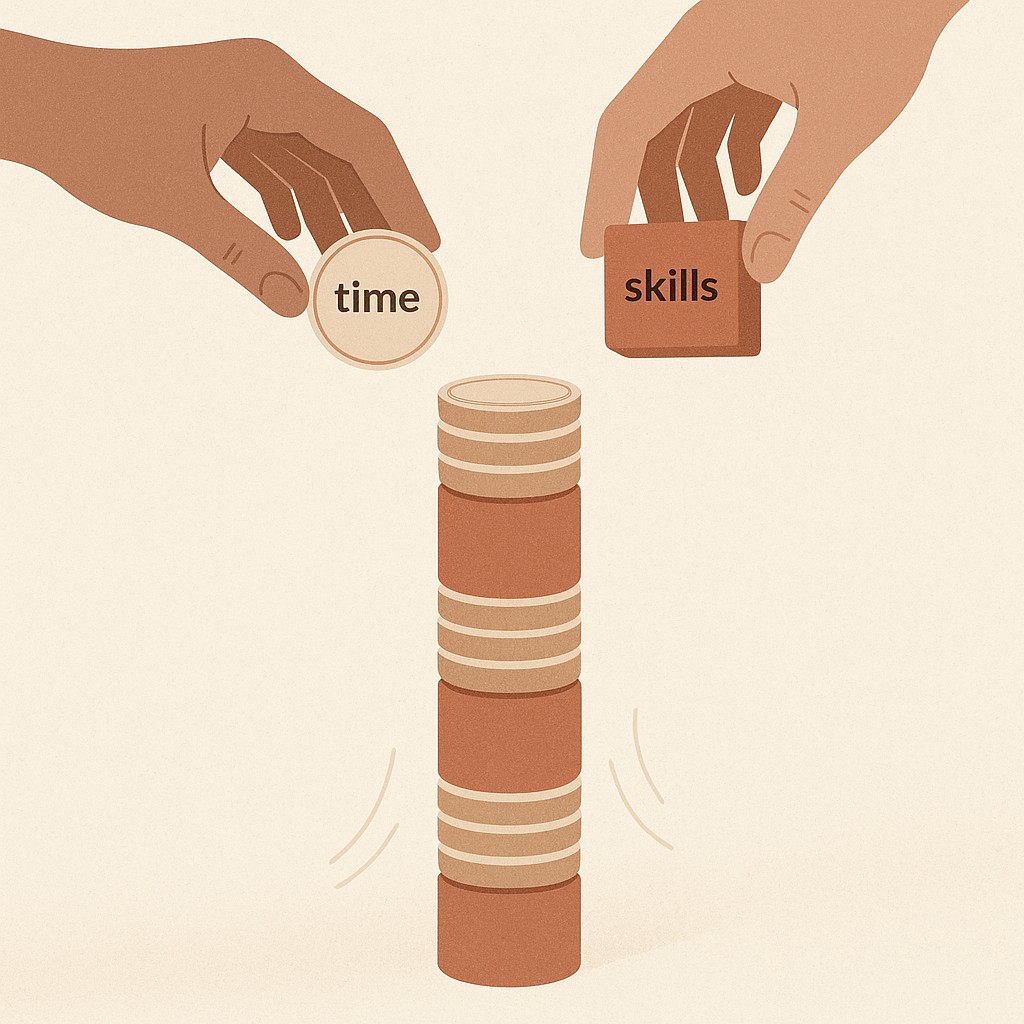Act on Your Values: A Practical Framework for Compounding Change
Act on Your Values: A Practical Framework for Compounding Change

The Moment Policy Got Real
Years ago, I stumbled across an episode of Freakonomics about Ranked Choice Voting. Just another commute, another podcast. But this one stuck with me.
It was a lightbulb moment. Suddenly, policy wasn’t abstract—policy was a lever.
Here’s what clicked: lasting progress begins when you act on your values. What actually shapes our world isn’t always who has the loudest opinions or the best arguments. It’s better to lead with empathy not data. Outcomes depend on the nuts and bolts—how we tally votes, set defaults, design incentives. If you want progress, the system has to reflect people’s actual preferences, not just whoever yells the best. Ensuring elections reflect the true will of the people isn’t just idealistic—it’s foundational to progress. Ranked Choice Voting, in that sense, isn’t a side quest for democracy nerds. It’s the operating system upgrade that affects everything built on top.
Still, it’s easy to fall back on sharing a thread, reading yet another op-ed, bookmarking studies for “later.” I kept confusing reading more with actually doing more. It felt productive, but nothing changed.
So what got me moving? Giving Tuesday. This manufactured moment built to nudge us out of endless analysis and into the first real step. I told myself, if I care about something, now’s the time to show it. One recurring contribution, a signal to myself as much as anyone else, that I want to align actions with values. You don’t need loud advocacy. Just consistent, small actions. They add up. That’s how belief turns into impact, one Tuesday (or whatever day you pick) at a time.
Stop Stalling and Start Compounding
I know the loop because I’ve lived it. You hear about some promising reform like Ranked Choice Voting, you open a dozen tabs, you join the Slack debate, you share that podcast episode—then you’re back at the feed, refreshing for new takes. It feels like momentum, but it’s really the pattern you have to overcome analysis paralysis to break. Classic spotting productivity theater. But weeks go by and nothing’s actually shipped. I’ve hit stretches where my calendar was packed with “policy chat” and “advocacy brainstorm.” My actual impact landed somewhere around zero.
If you’re an engineer, you get what I mean. Production isn’t the same as pushing code. Research isn’t the same as deploying. The difference shows up on your own dashboard. Plenty of intention, no commit to runtime. If that’s you, it’s not personal. You’re stuck in the default pattern.
But here’s the mental shift that finally worked for me. Progress isn’t a binary “big win” or “did nothing.” It’s a compounding loop. Small, repeated actions—whether minutes, dollars, or technical skills—don’t fade into the void. They add up, just like interest in a bank account. There’s solid math behind this: Tiny, repeatable actions aren’t wasted—micro-volunteering lets you contribute meaningfully even in less than 10 minutes. Stack enough of those on top of each other and you start to see movement where you thought there was only noise. Instead of waiting for that mythic “full weekend” or a “transformative donation,” I frame every commitment as a micro-deposit—a deliberate, actionable bet on outcomes piling up over time.

Three months ago, I started blocking a recurring 20-minute slot for one specific action on Ranked Choice Voting. I meant for it to be a placeholder, but it ended up anchoring the rest of my week. Funny how what feels minor sometimes ends up mattering more than the stuff you agonize over.
Worried about not having a spare Saturday? You don’t need one. You need fifteen to thirty minutes you can repeat. I started with a recurring 20-minute block, kept it—it’s a simple way to turn excuses into action, even on my busiest weeks.
And if you’re wondering whether those small donations or short bursts of effort really matter, look at what happens in aggregate: Recurring donors have a 77% higher revenue per donor than those who give just once, making small, steady gifts incredibly valuable. It’s all about consistency. The system works not because one gift is huge, but because many small ones create a reliable, predictable signal for organizations and policy change.
So if you’ve been stuck in research mode, here’s your nudge to turn beliefs into action. Don’t just think about what you support. Block out a time now—literally, right now—to commit. Giving Tuesday is your chance to put your money (or time) where your mouth is. Make it calendarable, make it repeatable, and finally see belief become action.
Act on Your Values: Make Action Your Default—A Practical Framework for Giving
Let’s cut through the indecision. When you’re picking where to invest your resources, try this: cause selection = leverage × tractability × personal alignment. Is this something where small inputs lead to big output (leverage)? Does it have realistic, concrete steps forward (tractability)? And do you actually care enough to stick with it (personal alignment)? If something hits all three, you’re not just moving dollars or hours—you’re shifting outcomes.
Now that you’ve got a cause, don’t overthink the long haul. Give yourself a ninety-day test drive. For the next three months, pick one organization or campaign. Set up an automatic, modest monthly donation.
Skip a fancy coffee or two if that makes it easier. Start by making your Giving Tuesday plan. Or stake out a single recurring calendar block to volunteer or contribute skills. If you code, that’s one PR or documentation update; if you organize, that’s a single outreach email. Committing to a quarter felt safer than promising myself forever. You can reevaluate after, but during those ninety days: no flaking, no rabbit holes, no adding “impact” to your browser bookmarks. There’s relief in not having to renegotiate your involvement every week.
You know that feeling when you set a personal improvement goal and then get lost in tracking the wrong metrics? I once spent half a day just reorganizing my browser bookmarks for “someday” projects, only to forget what half those projects were next month. I ended up re-finding the Ranked Choice Voting episode after deleting it from my podcast app—twice. There’s a lesson there, but I haven’t solved it. Some stuff just stays a bit out of reach.
Quick tangent. My brain loves optimizing the weirdest things. I clean my coffee grinder on a schedule stricter than my gym visits, and I once created a spreadsheet just for flossing streaks. But maintenance isn’t a weakness. When I started seeing recurring action in causes the way I see recurring chores, I stopped feeling guilty about not “doing more.” I just did something, regularly, and it stuck.
Here’s how you turn intent into routine. Automate your giving (even five dollars goes further than you think), block a monthly event on your calendar and guard your best morning hours, and decide on a “minimum viable action” in advance—engineers acting on values ship one bug fix, organizers send one support email, anyone shares one post. The surprising part? Over a single year, 77% of recurring donors stuck with their commitments compared to just 34% for one-time donors—predictable impact sticks. When there’s no debate about whether you’ll act, your impact compounds—quietly, but powerfully.
Whether it’s Ranked Choice Voting or another cause close to your heart, small consistent contributions can drive meaningful change. The mechanism doesn’t care what you choose, just that you move. Action creates momentum—momentum gets results.
How to Make Momentum: From Performed Support to Measured Change
Let me reframe something I wish I’d learned earlier. The real progress is private, not performative. I’ve posted about causes I hadn’t supported in months. That mismatch was a wake-up call. If you want impact, track the stuff that compounds—days you showed up, small but consistent donations, time spent, PRs merged. Not another tweet, not another retweet. You know what matters. Forget about applause. Aim for consistency only you can measure.
Here’s the simplest system I landed on—a dashboard stripped to bare essentials. One row for each month. Three cells: money, time, skills. Quick checkmark for completion. Nothing fancy, but it forces you to see patterns. Even a basic spreadsheet works. No need for bells and whistles.
Share progress sparingly, and when you do, aim for action not praise. Ask peers to join, commit, or help—don’t just announce you donated, invite others to actually do the same. Every time you post, offer a clear next step, not just a pat on the back.
Life spikes, always does. Travel, crunch periods, family. When that hits, don’t scrap the habit—shrink the goal. On rough weeks, toss in five dollars instead of twenty, fix a typo instead of a whole ticket, offer a single email introduction. I keep the cadence steady, even if the scope dips. The chain stays unbroken, and that’s what builds the momentum that actually moves systems over time.
Turn intention into visible action by generating clean, AI-assisted posts, emails, and updates in minutes, so you can share commitments, invite peers, and keep momentum without getting stuck in the drafting loop.
Commit, Repeat, Compound: The Step That Counts
Ever since I heard Freakonomics reframe Ranked Choice Voting from an abstract policy to a lever for real-world change, I’ve tried to adopt an act on your values mindset by making sure my calendar and card statement actually mirror what I claim to value. It wasn’t an overnight switch—old habits die slow. But once I started using temporal markers (like Giving Tuesday, or the first of every month) as little triggers, it got easier to see action as a simple, repeatable move, not a philosophical leap. That initial shift stuck with me. Systems only respond when someone moves first.
Right now, here’s your move. Stop scrolling and go face-to-face with the donation page of a cause you believe in. Pick a moment—this one, not later—and actually commit.
To turn belief into compounding change, walk it out once. Pick one cause or campaign you want your resources to back. Set a recurring amount (even minimal amounts count) or block a regular time on your calendar. Choose one core skill or action you can contribute. And schedule your first touchpoint today—literally lock it into your phone, your desktop, wherever you track time. These four steps take five minutes, but map directly to ongoing impact.
Real alignment breeds momentum, and momentum—when repeated—compounds into systems-level change. The proof’s in your history, one action at a time.
Enjoyed this post? For more insights on engineering leadership, mindful productivity, and navigating the modern workday, follow me on LinkedIn to stay inspired and join the conversation.
You can also view and comment on the original post here .
